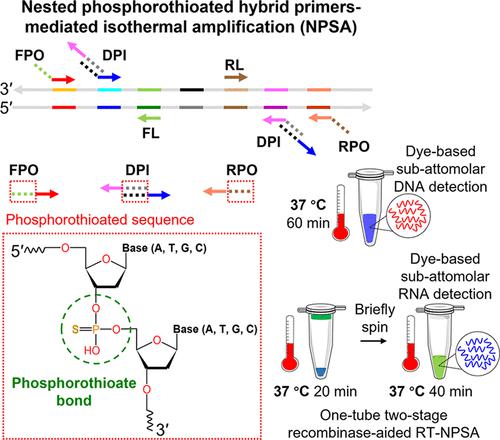Our official English website, www.x-mol.net, welcomes your feedback! (Note: you will need to create a separate account there.)
Nested Phosphorothioated Hybrid Primer-Mediated Isothermal Amplification for Specific and Dye-Based Subattomolar Nucleic Acid Detection at Low Temperatures
ACS Sensors ( IF 8.9 ) Pub Date : 2023-03-03 , DOI: 10.1021/acssensors.2c02754 Yaru Wang 1, 2 , Lanxiang Zhang 1, 2 , Yuqing Shen 1, 2 , Evan Yi-Wen Yu 1, 3 , Xiong Ding 1, 2
ACS Sensors ( IF 8.9 ) Pub Date : 2023-03-03 , DOI: 10.1021/acssensors.2c02754 Yaru Wang 1, 2 , Lanxiang Zhang 1, 2 , Yuqing Shen 1, 2 , Evan Yi-Wen Yu 1, 3 , Xiong Ding 1, 2
Affiliation

|
Developing dye-based isothermal nucleic acid amplification (INAA) at low temperatures such as 37 °C remains a technical challenge. Here, we describe a nested phosphorothioated (PS) hybrid primer-mediated isothermal amplification (NPSA) assay which only utilizes EvaGreen (a DNA-binding dye) to achieve specific and dye-based subattomolar nucleic acid detection at 37 °C. The success of low-temperature NPSA essentially depends on employing Bacillus smithii DNA polymerase, a strand-displacing DNA polymerase with wide range of activation temperature. However, the NPSA’s high efficiency entails nested PS-modified hybrid primers and the additives of urea and T4 Gene 32 Protein. To address the inhibition of urea on reverse transcription (RT), one-tube two-stage recombinase-aided RT-NPSA (rRT-NPSA) is established. By targeting human Kirsten rat sarcoma viral (KRAS) oncogene, NPSA (rRT-NPSA) stably detects 0.2 aM of KRAS gene (mRNA) within 90 (60) min. In addition, rRT-NPSA possesses subattomolar sensitivity to detect human ribosomal protein L13 mRNA. The NPSA/rRT-NPSA assays are also validated to obtain consistent results with PCR/RT-PCR methods on qualitatively detecting DNA/mRNA targets extracted from cultured cells and clinical samples. As a dye-based, low-temperature INAA method, NPSA inherently facilitates the development of miniaturized diagnostic biosensors.
中文翻译:

嵌套硫代磷酸化杂交引物介导的等温扩增用于低温下特异性和基于染料的亚阿托摩尔核酸检测
在 37 °C 等低温下开发基于染料的等温核酸扩增 (INAA) 仍然是一项技术挑战。在这里,我们描述了一种嵌套的硫代磷酸化 (PS) 混合引物介导的等温扩增 (NPSA) 测定,它仅利用 EvaGreen(一种 DNA 结合染料)在 37 °C 下实现特异性和基于染料的亚阿托摩尔核酸检测。低温 NPSA 的成功基本上取决于使用史密斯芽孢杆菌DNA 聚合酶,一种具有广泛活化温度的链置换 DNA 聚合酶。然而,NPSA 的高效率需要嵌套的 PS 修饰的杂交引物以及尿素和 T4 基因 32 蛋白的添加剂。为了解决尿素对逆转录 (RT) 的抑制,建立了单管两阶段重组酶辅助 RT-NPSA (rRT-NPSA)。通过靶向人类 Kirsten 大鼠肉瘤病毒 ( KRAS ) 致癌基因,NPSA (rRT-NPSA) 在 90 (60) 分钟内稳定检测到 0.2 aM 的KRAS基因 (mRNA)。此外,rRT-NPSA 具有检测人核糖体蛋白 L13 mRNA 的亚摩尔灵敏度。NPSA/rRT-NPSA 检测也经过验证,可获得与 PCR/ RT一致的结果- 用于定性检测从培养细胞和临床样本中提取的 DNA/mRNA 靶标的 PCR 方法。作为一种基于染料的低温 INAA 方法,NPSA 从本质上促进了微型诊断生物传感器的开发。
更新日期:2023-03-03
中文翻译:

嵌套硫代磷酸化杂交引物介导的等温扩增用于低温下特异性和基于染料的亚阿托摩尔核酸检测
在 37 °C 等低温下开发基于染料的等温核酸扩增 (INAA) 仍然是一项技术挑战。在这里,我们描述了一种嵌套的硫代磷酸化 (PS) 混合引物介导的等温扩增 (NPSA) 测定,它仅利用 EvaGreen(一种 DNA 结合染料)在 37 °C 下实现特异性和基于染料的亚阿托摩尔核酸检测。低温 NPSA 的成功基本上取决于使用史密斯芽孢杆菌DNA 聚合酶,一种具有广泛活化温度的链置换 DNA 聚合酶。然而,NPSA 的高效率需要嵌套的 PS 修饰的杂交引物以及尿素和 T4 基因 32 蛋白的添加剂。为了解决尿素对逆转录 (RT) 的抑制,建立了单管两阶段重组酶辅助 RT-NPSA (rRT-NPSA)。通过靶向人类 Kirsten 大鼠肉瘤病毒 ( KRAS ) 致癌基因,NPSA (rRT-NPSA) 在 90 (60) 分钟内稳定检测到 0.2 aM 的KRAS基因 (mRNA)。此外,rRT-NPSA 具有检测人核糖体蛋白 L13 mRNA 的亚摩尔灵敏度。NPSA/rRT-NPSA 检测也经过验证,可获得与 PCR/ RT一致的结果- 用于定性检测从培养细胞和临床样本中提取的 DNA/mRNA 靶标的 PCR 方法。作为一种基于染料的低温 INAA 方法,NPSA 从本质上促进了微型诊断生物传感器的开发。



























 京公网安备 11010802027423号
京公网安备 11010802027423号